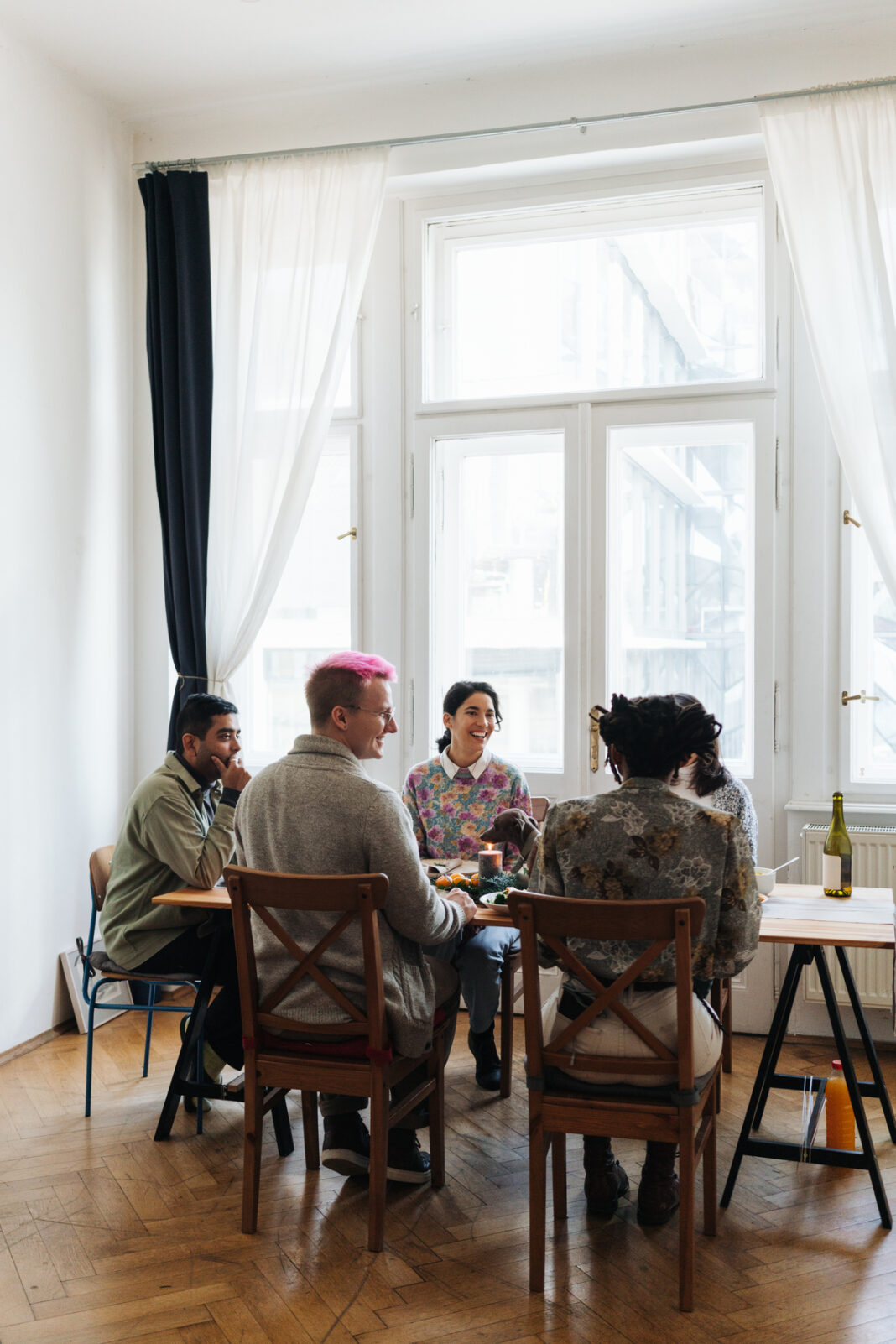Ever since I moved into my apartment building, I remember people leaving their junk in the lobby. And I mean “junk” in the very best way. It was wonderful junk! Incredible junk. As the saying goes, trash to one is treasure to another. It was a seemingly airtight system. Whenever someone didn’t want something, they’d leave it in the lobby, and whenever something was left in the lobby, it was up for grabs. Through this system, I found two unique bedside tables, a banker’s desk lamp, a matching set of wine decanters, a matching set of crystal whiskey glasses, the perfect oversized denim jacket, and so much more. I’ve also done a fair share of gifting this way, having donated numerous clothes, a pair of heels, a set of sheets, a nightstand, and books of all kinds. The system seemed perfect — until the unforgettable day that someone trashed the lobby.
“Whenever someone didn’t want something, they’d leave it in the lobby, and whenever something was left in the lobby, it was up for grabs.”
Perhaps in the chaos of someone moving out (perhaps in a state of emotional or literal disorganisation? Carelessness? Grief? Exhaustion? We’ll never know), one day the lobby became filled with heaps of trash. Actual garbage — piles of old newspapers, full trash bags that smelled of rotten food, pieces of disassembled worn down furniture, broken dishes and kitchen appliances, as far as the eye could see. It was clear that someone, for whatever reason, understood our idiosyncratic system of communal giving and taking (I used to call it “lobby mutual aid”), and decided to use it to their advantage. Our super, who lives across the hall from me, told me that he had to clean up the entire mess himself, which I’m sure was not an easy feat. It looked like a grimy beaver dam, so tightly packed.
“Without any emphasis on community or accountability, it was only a matter of time before someone went rogue on their way out.”
A few days after the lobby was cleaned out, a sign appeared on the wall that read “This area is not a dumpsite. It is an extension of your home. Do not leave anything in this area.” accompanied by another sign that pointed to a newly-installed security camera saying, “Smile, you’re on camera!” I understood right away that this was the end of our lobby mutual aid, and it was understandable. Our lobby system had so many benefits, but without any emphasis on community or accountability, it was only a matter of time before someone went rogue on their way out.
This gave me an idea. At first, I wasn’t sure anyone would go for it. What we had in our lobby was a causal system for which nobody had to actually opt in. Nobody had to lay their cards on the table and admit, “Hey, I’d like to be a part of something, here.” We all just happened upon items and left items behind. With my new system, we would have to actively engage with one another — and in a place that’s practically become the poster child for the “nobody knows their neighbors” trope, I was worried that people would be too cool for school about it. But before assuming everyone would automatically opt out, someone needed to take the first step and create something for which one had the choice to opt in.
“Before assuming everyone would automatically opt out, someone needed to take the first step and create something for which one had the choice to opt in.”
Setting it up was incredibly easy. It took about 45 minutes, if that. I created a WhatsApp group called “[building name] Buy Nothing” for which I was the admin, created a QR code to link to the group, and drafted up a flyer with the QR code that said, “We once left our unwanted items in the lobby, but now we can share without the hassle! Introducing a Buy-Nothing group JUST for the people of [building name].”
I hung it in the lobby, and to my amazement, people began to trickle in right away. (Here’s the exact template I used to create my flyer, in case you’re interested!)
What I expected when I started the Buy-Nothing group for our building was maybe a similar feeling to local or neighborhood Buy-Nothing groups on Facebook (which is where I got both the concept and the name), and to keep the lobby clear. But from the jump, something about the group was different. We began to offer up items that we might have once found in the lobby, but also things that we might have hesitated to leave in the lobby for whatever reason. Items that are large and heavy like bigger furniture pieces that would take up too much space, items that are nice and expensive that we want to make sure go to someone who actually wants them, items that are small or fragile like beads and crafting supplies. People also offer up food in the group now. I recently rehomed a bag of white rice I purchased accidentally and a coffee flavoring syrup I outgrew.
“By simply scanning a QR code and entering into this mutual space of agreement and community, there’s an automatic sense of safety and security when it comes to offering up items.”
By simply scanning a QR code and entering into this mutual space of agreement and community, there’s an automatic sense of safety and security when it comes to offering up items. I gave away a blender in the group. Others have given away a bed frame, a compost machine, a record player, a dresser, a pair of (very nice, I know this because I was the recipient) leather loafers. We often give the group first dibs on great stuff, both because of the convenience of the whole exchange happening in our own building, and because we know it’s the kind of place where others do the same, and therefore we all do our part and contribute. One of my neighbors told me that only after nobody in the WhatsApp group wanted her very nice pour-over coffee set did she choose to sell it on Facebook Marketplace. The Buy-Nothing group was the very first place she offered it, even though she could have simply sold it.
The secondary effects of this community have been even more delightful and surprising. Although the group primarily functions as this buy-nothing space, we’ve built the trust and comfort as neighbors to ask each other questions, requesting help or advice from one another. One of our neighbors asked about the legalities of adding a partner to their lease, and my boyfriend chimed in to offer up the wealth of information he’d amassed from back when I moved in. Someone else asked about our building’s policies on putting holes in our walls, and another neighbor informed them.
Now, people don’t just offer things, but they also ask for things. Someone who recently moved in asked the chat if anyone had some chairs and a lamp, and the requested items materialized! And, in a way that feels truly classic, we’ve become a building where you can literally ask your neighbor to borrow a cup of sugar. Recently, my upstairs neighbor asked if anyone could lend a dash of paprika to go in a mac n cheese recipe, and multiple people offered.
“In a way that feels truly classic, we’ve become a building where you can literally ask your neighbor to borrow a cup of sugar.”
There’s something quixotic and old-fashioned about having a community of neighbors like this in New York City of all places, even though it took a QR code and a WhatsApp group to get it started. Now, not only do we have a designated place to rehome our junk and discover new treasures, but we also have a place where we put names to faces to apartment numbers. When we meet up with someone to give something away or to pick something up, it’s a chance to introduce yourself to someone you may have seen hundreds of times in the hallway. You get to go, “Oh, that person who held the door open for me that one time is named Ken, and they live in 4D and they now own this jacket I don’t need anymore.”
Our building feels like a community in a way that very few do nowadays, and it makes me hopeful to know that tech can still indeed be used to bring people together — and not just people who are far apart but people who live right next to each other in the same building.
“Our building feels like a community in a way that very few do nowadays, and it makes me hopeful to know that tech can still indeed be used to bring people together.”
My flyer with the QR code is still hanging in the lobby — the super even put a sign above it that says “PLEASE READ.” The group now has 26 people in it, and it continues to grow as existing neighbors get intrigued and new neighbors move in. I am so amazed that all it took was putting myself out there. So often in this modern world, we tell ourselves that neighborhoods and apartment buildings are simply not the way they used to be, and there’s nothing we can do about it. But there’s so much power in reaching out, because the thing that nobody tells you is how hungry we all are for a trusting, supportive community. Being the first person to extend your hand can often feel risky, but it can also mean starting something truly beautiful and deeply needed.
When you give people a place to connect, amazing things happen. We all have the power to transform our communities with our willingness to participate — our presence can go a long way. My apartment building really is a community now. And the great thing is, there’s nothing special or unique about my building. My apartment building is just like any other apartment building in New York. If I can do it, anyone can. All you need is a printer — and if you don’t have one, maybe knock on a door and ask your neighbor.
Jamie Kahn is a writer and yoga teacher based in New York. Her work has been featured in Glamour, Brooklyn Magazine, Epiphany, The Evergreen Review, and others.


